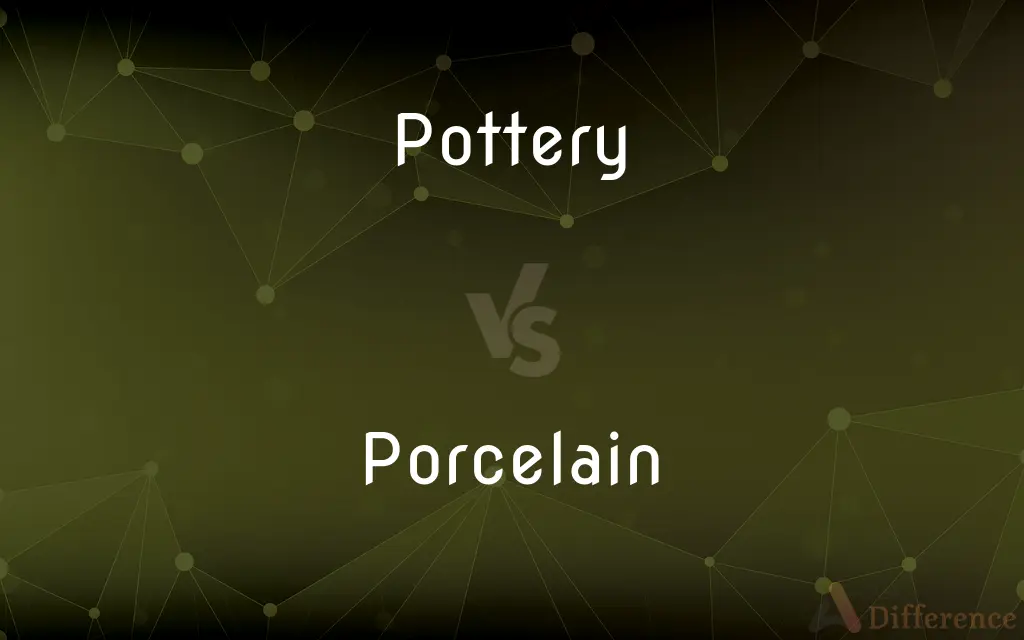Pottery vs. Porcelain — What's the Difference?
By Tayyaba Rehman & Maham Liaqat — Updated on April 16, 2024
Pottery is typically made from various clays and fired at lower temperatures, resulting in a more porous and less translucent material, while porcelain, made from kaolin clay, is fired at higher temperatures, achieving greater strength and translucency.

Difference Between Pottery and Porcelain
Table of Contents
ADVERTISEMENT
Key Differences
Pottery is crafted from various earthenware clays, which are abundant and versatile, suitable for functional and decorative items. On the other hand, porcelain is specifically made from a refined clay called kaolin, combined with feldspar and quartz, leading to a more specific usage in fine art and high-end dishware.
Pottery is generally fired at temperatures ranging from about 1,000 to 1,200 degrees Celsius, which makes it somewhat porous and not naturally waterproof. Whereas porcelain is fired at higher temperatures, between 1,200 to 1,450 degrees Celsius, making it vitrified, non-porous, and often naturally white and translucent.
The aesthetic of pottery is often rustic, earthy, and visibly textured, reflecting the natural qualities of the clay used. In contrast, porcelain is valued for its smoothness, whiteness, and a glass-like finish that can be highly decorative.
Pottery can be suitable for everyday use and typically withstands less handling delicacy compared to porcelain. Conversely, porcelain is often seen in settings that demand elegance and durability, such as fine dining and collectible art pieces.
Pottery is more tolerant of sudden temperature changes and less likely to crack compared to porcelain, which requires more careful handling due to its fine and brittle nature when thin.
ADVERTISEMENT
Comparison Chart
Material
Various clays
Kaolin clay, feldspar, quartz
Firing Temperature
1,000°C - 1,200°C
1,200°C - 1,450°C
Porosity
Porous, often requires glazing
Vitrified, non-porous
Aesthetic
Rustic, earthy
Smooth, white, translucent
Typical Use
Everyday items, decorative art
Fine art, high-end dishware, ornaments
Compare with Definitions
Pottery
The premises or building where clay items are made and fired.
He converted his garage into a small pottery studio.
Porcelain
High-quality, often expensive, tableware and ornamental objects.
Her grandmother's porcelain teacups were her most treasured heirlooms.
Pottery
A style of ceramic that is often more rustic and less refined.
The pottery vase matched the country style of her kitchen.
Porcelain
A type of ceramic made by firing refined materials including kaolin at high temperatures.
The museum displayed an exquisite collection of Chinese porcelain.
Pottery
A craft of making objects by shaping and firing clay.
She attended a workshop to learn about the basics of pottery.
Porcelain
Artistic objects made from a material that can be molded and glazed.
The artist crafted a delicate porcelain sculpture.
Pottery
Objects made from firing clay at relatively low temperatures.
The market stall was filled with pottery of all sizes.
Porcelain
Represents luxury and craftsmanship in ceramics.
The porcelain figurines are considered a pinnacle of ceramic artistry.
Pottery
An art form practiced worldwide, varying greatly in style and technique.
Pottery classes explore various techniques from different cultures.
Porcelain
Known for its strength, whiteness, and translucency after firing.
Porcelain dinnerware is often used for special occasions.
Pottery
Ware, such as vases, pots, bowls, or plates, shaped from moist clay and hardened by heat.
Porcelain
Porcelain () is a ceramic material made by heating materials, generally including a material like kaolin, in a kiln to temperatures between 1,200 and 1,400 °C (2,200 and 2,600 °F). The strength, and translucence of porcelain, relative to other types of pottery, arises mainly from vitrification and the formation of the mineral mullite within the body at these high temperatures.
Pottery
The craft or occupation of a potter.
Porcelain
A hard, white, translucent ceramic made by firing a pure clay and then glazing it with variously colored fusible materials; china.
Pottery
The place where a potter works.
Porcelain
An object made of this substance.
Pottery
Fired ceramic wares that contain clay when formed.
The shelves were lined with pottery of all shapes and sizes.
Porcelain
A hard white translucent ceramic, originally made by firing kaolin, quartz, and feldspar at high temperatures but now also inclusive of similar artificial materials; also often (figurative) such a material as a symbol of the fragility, elegance, etc. traditionally associated with porcelain goods.
Tableware and toilets are both made of porcelain.
Pottery
(countable) A potter's shop or workshop, where pottery is made.
I visited the old potteries and saw the pots being made.
Porcelain
Syn of china: porcelain tableware.
He set the table with our porcelain and stemware.
Pottery
The potter's craft or art: making vessels from clay.
Bernard Leach was skilled at pottery.
Porcelain
Syn of kaolin: the kind of clay traditionally used in China to manufacture porcelain.
Pottery
The vessels or ware made by potters; earthenware, glazed and baked.
Porcelain
An object made of porcelain, (particularly) art objects or items of tableware.
The museum has an extensive collection of rare Chinese porcelains.
Pottery
The place where earthen vessels are made.
Porcelain
Syn of cowrie.
Pottery
Ceramic ware made from clay and baked in a kiln
Porcelain
Syn of wampum: strings of shells, beads, etc. used as ornamentation or currency; the composite shells, beads, etc.
Pottery
The craft of making earthenware
Porcelain
A kind of pigeon with deep brown and off-white feathers.
Pottery
A workshop where clayware is made
Porcelain
Purslain.
Porcelain
A fine translucent or semitransculent kind of earthenware, made first in China and Japan, but now also in Europe and America; - called also China, or China ware.
Porcelain, by being pure, is apt to break.
Porcelain
Ceramic ware made of a more or less translucent ceramic
Common Curiosities
How does the aesthetic appeal of pottery differ from that of porcelain?
Pottery has a rustic and earthy appearance, while porcelain is known for its smooth, white, and translucent qualities.
How does the porosity of pottery compare to porcelain?
Pottery is more porous than porcelain, which is vitrified and non-porous.
At what temperatures are pottery and porcelain typically fired?
Pottery is fired at temperatures between 1,000°C and 1,200°C, whereas porcelain is fired between 1,200°C and 1,450°C.
What is the primary material difference between pottery and porcelain?
Pottery is made from various earthen clays, while porcelain is primarily made from kaolin clay.
Is pottery more durable than porcelain?
Pottery is less prone to cracking from sudden temperature changes, making it generally more durable in everyday use.
Can pottery be used for the same purposes as porcelain?
While some pottery can be used similarly to porcelain, porcelain is often preferred for high-end applications due to its strength and aesthetic qualities.
How are pottery and porcelain crafted differently?
The main difference lies in the materials used and the firing temperatures, which affect the properties and uses of the final products.
What are the typical uses of pottery compared to porcelain?
Pottery is often used for everyday items and rustic decorative art, while porcelain is used for fine art and high-end dishware.
What is a common setting where porcelain might be preferred over pottery?
Porcelain is preferred in settings requiring elegance and durability, such as in fine dining establishments.
What are the environmental impacts of producing pottery versus porcelain?
Both have environmental impacts, but porcelain's higher firing temperature could mean it has a higher energy consumption.
Are there different types of pottery and porcelain?
Yes, there are various types of both, determined by the clay used, the firing temperature, and the specific techniques employed.
Can both pottery and porcelain be painted and glazed?
Yes, both can be painted and glazed, although the techniques and types of glazes used may differ.
Why is porcelain often more expensive than pottery?
The materials for porcelain are more refined, and the higher firing temperature requires more precision and energy, contributing to its higher cost.
Which is more historically significant, pottery or porcelain?
Both have significant historical value, but porcelain is often associated with specific periods and regions, such as imperial China.
How should porcelain be handled compared to pottery?
Porcelain, especially when thin, should be handled more carefully due to its brittle nature.
Share Your Discovery

Previous Comparison
Frail vs. Fragile
Next Comparison
Couch vs. ArmchairAuthor Spotlight
Written by
Tayyaba RehmanTayyaba Rehman is a distinguished writer, currently serving as a primary contributor to askdifference.com. As a researcher in semantics and etymology, Tayyaba's passion for the complexity of languages and their distinctions has found a perfect home on the platform. Tayyaba delves into the intricacies of language, distinguishing between commonly confused words and phrases, thereby providing clarity for readers worldwide.
Co-written by
Maham Liaqat















































